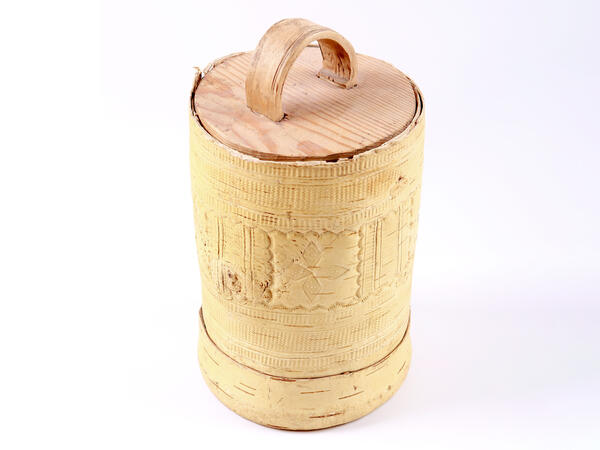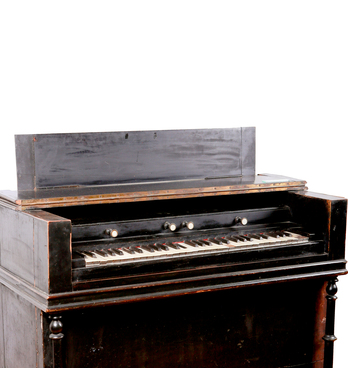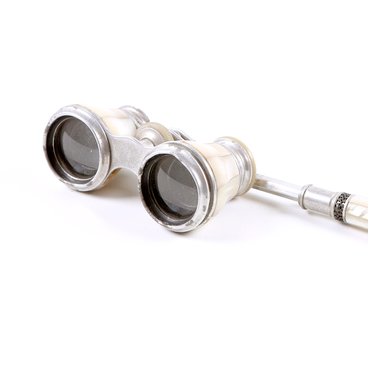The exhibition of the Kasimov Museum-Reserve contains a tues — a cylindrical vessel in which food and drinks were stored. In the past centuries, metal and glass utensils were rare and expensive, and birch bark was considered to be an expedient material which was easy to get. Therefore, such birch-bark containers were made in different regions of Russia, including the Kasimov District.
Scientists suggested the word ‘tues’ came from the Northern Russian dialects that got it from the Komi language, where ‘toy’ meant birch bark. The word is not used in the modern Komi language anymore, but its single-root word ‘tuyis’, a small birch-bark container, has been preserved.
Tues was made from birch bark — dried bark of birch. The inner wall was made of a single sheet without any seams and joints so that products neither poured out nor spilled. Skoloten was used for that. Skoloten is a piece of bark which was completely removed from freshly sawn birch in spring and early summer: at this time of the year it is easily removed from the trunk.
The outside of the tues was decorated with paintings, lace grooving ornaments or embossment. Some craftsmen wove a relief pattern from narrow strips of birch bark. The outer wall of the tues was called a shirt due to its rich decoration items.
Dry goods and drinks were stored inside the container. For example, they were salt, cereals, dry herbs, tea, bay leaf, honey, mors (a Russian fruit drink prepared from berries), kvass (a traditional beverage made from rye bread) or any other drinks.
Tues is considered to be the predecessor of the modern vacuum flasks: its case was multi-layered which helped drinks keep the temperature for a long time. For instance, tues was used to keep cold water, milk, kvass or even hot tea. Such flasks were often used by hunters and fishermen; harvesters and farmers used to take it to work in the field.
In Ancient Russia, a birch-bark tues was spread among Russian villagers. Tues was mostly made by men. It was quite difficult to create such a vessel: first you should carefully remove the bark from birch so that not to damage it, then steam the workpiece out and insert it into the wooden bottom. When the birch bark was cool and dry, it became smaller in size and thus closely covered the base of the vessel.
After that, the lid was made. It was chosen thoroughly according to the size so that tues could be closed tightly. The lid was often made with a birch-bark handle. Nowadays tues is produced only as souvenirs.
Scientists suggested the word ‘tues’ came from the Northern Russian dialects that got it from the Komi language, where ‘toy’ meant birch bark. The word is not used in the modern Komi language anymore, but its single-root word ‘tuyis’, a small birch-bark container, has been preserved.
Tues was made from birch bark — dried bark of birch. The inner wall was made of a single sheet without any seams and joints so that products neither poured out nor spilled. Skoloten was used for that. Skoloten is a piece of bark which was completely removed from freshly sawn birch in spring and early summer: at this time of the year it is easily removed from the trunk.
The outside of the tues was decorated with paintings, lace grooving ornaments or embossment. Some craftsmen wove a relief pattern from narrow strips of birch bark. The outer wall of the tues was called a shirt due to its rich decoration items.
Dry goods and drinks were stored inside the container. For example, they were salt, cereals, dry herbs, tea, bay leaf, honey, mors (a Russian fruit drink prepared from berries), kvass (a traditional beverage made from rye bread) or any other drinks.
Tues is considered to be the predecessor of the modern vacuum flasks: its case was multi-layered which helped drinks keep the temperature for a long time. For instance, tues was used to keep cold water, milk, kvass or even hot tea. Such flasks were often used by hunters and fishermen; harvesters and farmers used to take it to work in the field.
In Ancient Russia, a birch-bark tues was spread among Russian villagers. Tues was mostly made by men. It was quite difficult to create such a vessel: first you should carefully remove the bark from birch so that not to damage it, then steam the workpiece out and insert it into the wooden bottom. When the birch bark was cool and dry, it became smaller in size and thus closely covered the base of the vessel.
After that, the lid was made. It was chosen thoroughly according to the size so that tues could be closed tightly. The lid was often made with a birch-bark handle. Nowadays tues is produced only as souvenirs.


